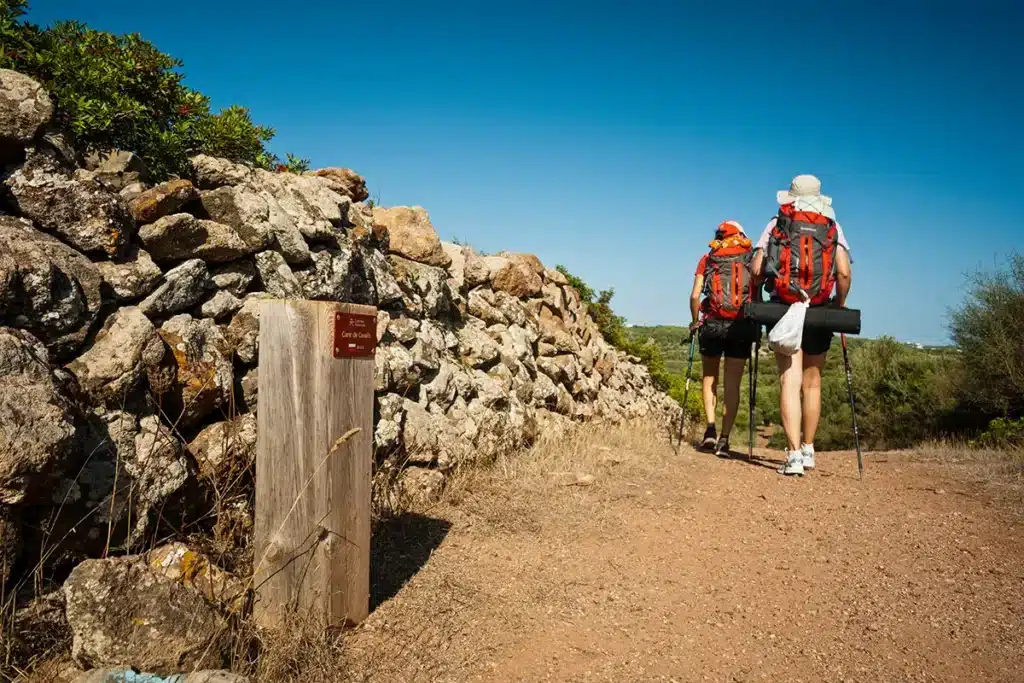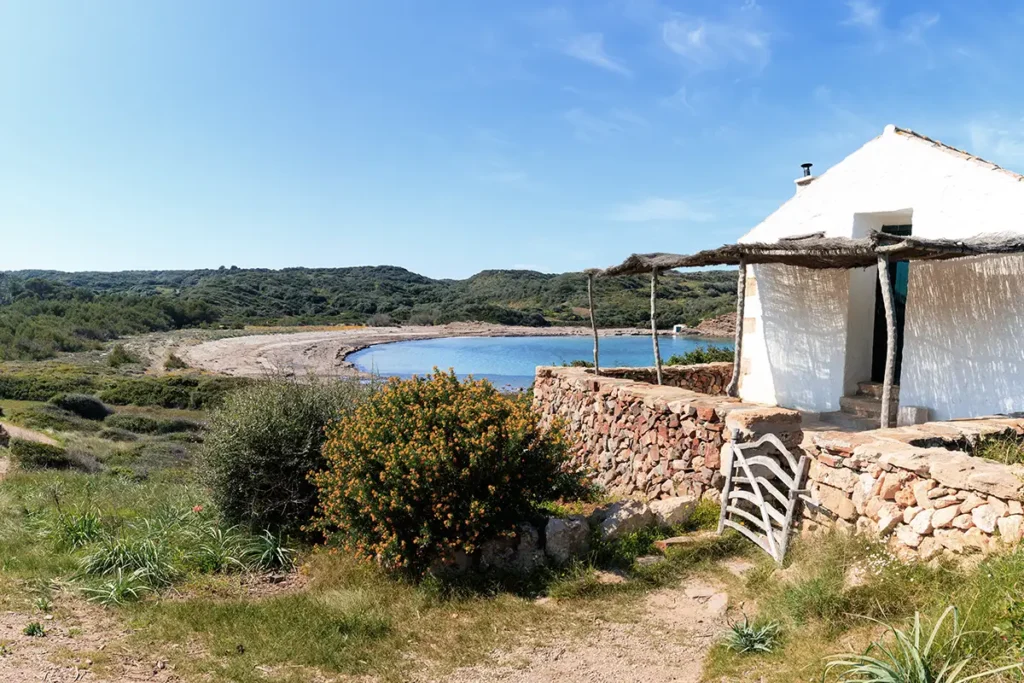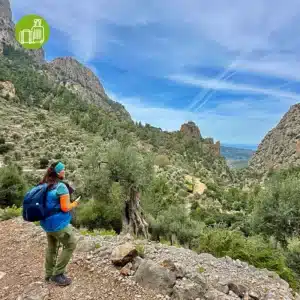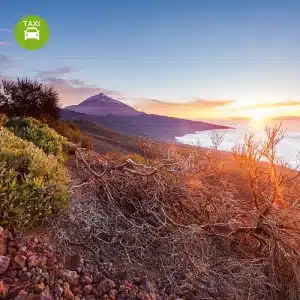06 Jun Coastal Path Menorca
Coastal Path Menorca: discovering Menorca step by step
Walking the Coastal Path Menorca is much more than a trail.
The Coastal Path Menorca is a 185-kilometre circular route that circles the entire coast of the island, offering the walker a journey through changing landscapes, unique ecosystems and corners that cannot be discovered in any other way. Walking along it, you will understand why Menorca was declared a Biosphere Reserve by UNESCO: wild nature, unspoilt beaches, steep cliffs, ravines, agricultural areas and a deep sense of balance between man and environment.
This old coastal path, of military origin, has been recovered and adapted for hiking, becoming the GR 223. It is divided into 20 signposted stages, making it possible to organise the walk in a flexible way, either doing short sections or the whole route in 8 to 10 days. Along the route, you can see defence towers, lighthouses, old watchtowers and stone paths that tell the story of an island that knew how to protect its coastline.
If you are looking for a different and profound way to discover Menorca, far from the crowds, this trail offers you a unique opportunity. Whether alone, as a couple or in a group, walking the Coastal Path Menorca is a gift of time, connection and silence.
For more information on self-guided programmes and personalised packages, you can visit natour.travel and discover all the options available for this adventure.
Stages of the Coastal Path Menorca
The Coastal Path of Menorca is divided into 20 well-marked stages. You can cover the whole route in about 10 days, or choose just a few sections depending on your fitness level and availability.
Some recommended stretches:
- Cala Morell to Punta Nati: arid landscapes and northern cliffs.
- Binimel·là to Cala Pregonda: reddish sand and volcanic formations.
- Faro de Favàritx to Es Grau: passing through the natural park.
You can find full details of the coastal path stages on the Menorca tourism website or on the Natour Travel website, where you can also find guidance on which sections to choose according to your profile.
Tips for the Coastal Path Menorca
- Avoid the hottest hours of the day, especially in summer.
- Take appropriate footwear, sunscreen, water and some food.
- Respect the natural environment and do not leave litter.
- Use maps or GPS apps, although the route is well signposted.
Remember that if you do the tour with a company like Natour Travel, you don’t have to worry about the logistics: they organise the transfers, they lodge you in selected places and they offer you assistance in case of emergency.
Why choose the Coastal Path Menorca?
This is a different and unique way of getting to know Menorca. Far from conventional tourism, this experience connects you with the soul of the island: its changing landscapes, its rural culture and its respect for the environment.
What’s more, the route combines sea and mountains, tradition and history, and is suitable for both experienced hikers and those who are just looking for a few days’ walk along the coast.
Useful resources
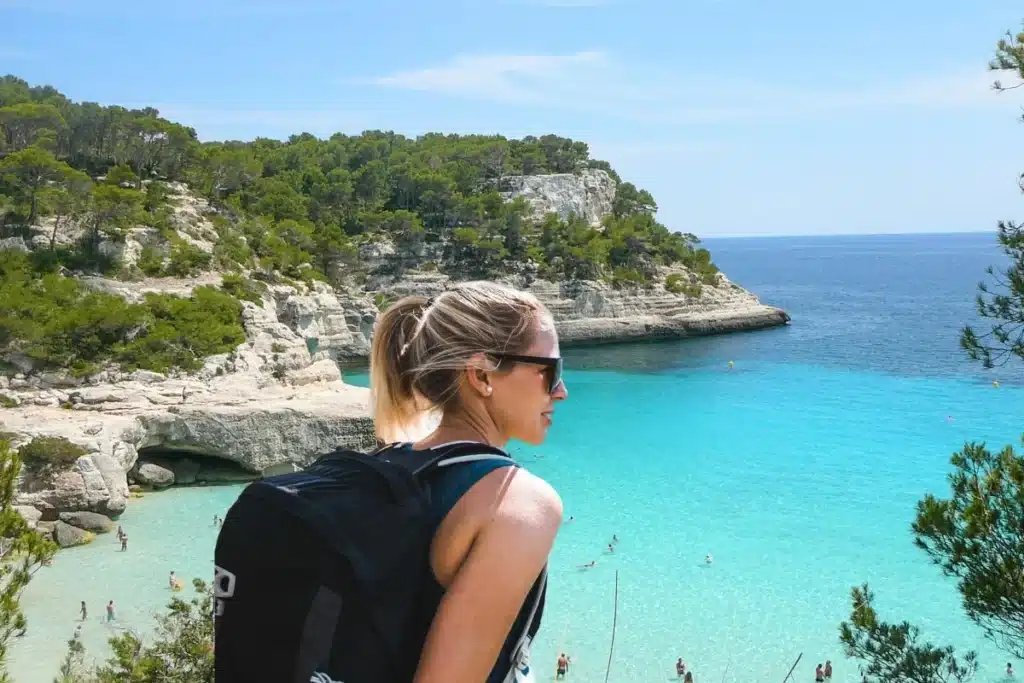
A look at the history of the Coastal Path Menorca
The Coastal Path Menorca is a historic route that completely encircles the island of Menorca, with a rich history that spans several centuries.
Medieval origins (14th century)
The origin of the Coastal Path Menorca is uncertain, but its origins could date back to the cavalry, the system in charge of defending the island, around the 14th century. In the 14th century, King Jaume II ordered the knights of Menorca to keep an armed horse for the defence of the island and its inhabitants, which is considered to be the possible origin of the name and function of the path.
Early documents (17th century)
Later documents, from the 17th century, refer to it as the ‘Camí de Cavallers’ (Knight’s Way), showing its importance as a military and coastal surveillance route.
Original military function
The original function of the Coastal Path was military in nature: it was a speculative road, a road used by the lighthouse keepers to guard the coast. This was crucial because in the context of a very insecure Mediterranean, Menorca was an island under the eternal threat of pirate raids.
British period (18th century)
During the British domination of Menorca in the 18th century, the road acquired great importance. British Governor Kane spoke of it as a “royal road” and ordered it to be kept “clean and passable, as it was in the old days”. It was precisely during British rule that it acquired the name “Camí de Cavalls” (Horse Path) due to the intense traffic of soldiers patrolling the island on horseback.
Civilian use
In addition to its military function, it was also used by the Menorcan population as a means of public communication, which is why it was of great benefit to agriculture, fishing and local commerce The Coastal Path Menorca: history, stages and excursions.
Rehabilitation and maintenance
Both the English and the French, during their dominations in the 18th century, took care of rehabilitating certain sections of the Coastal Path Menorca and preparing it for their use. The defence towers along the route date from the 18th and 19th centuries and were built by the English and Spanish.
Modern times
During the 20th century, the Coastal Path Menorca fell into disuse, but at the end of the 1980s a popular campaign was launched in defence of the Coastal Path Menorca for its cultural, historical and scenic value, which led to its recovery and declaration as an Asset of Cultural Interest.
Today, the Coastal Path Menorca has become one of the most important hiking routes in the Mediterranean, allowing you to walk the 185 kilometres of Menorca’s coastal perimeter and discover its landscapes, beaches and historical heritage.
Frequently Asked Questions
What basic equipment do I need for hiking alone? Essential equipment includes: a suitable backpack, hiking boots, layered clothing, a map and compass or GPS, a first aid kit, sufficient water, energy-rich food, a torch or headlamp, an emergency whistle, and sun protection.
How do I choose the right route for my level of experience? Start with well-marked and popular trails, check the technical difficulty, distance and elevation gain, check the weather conditions, read reviews from other hikers, and always choose routes slightly below your limit when hiking alone.
What safety precautions should I take when hiking alone? Tell someone you trust your route and estimated time of return, carry an emergency communication device, leave early to avoid darkness, stay on marked trails, trust your instincts if something doesn’t feel right, and have an escape plan.
How much water should I bring on a day hike? The general recommendation is 0.5-1 litre for every 2 hours of walking, plus extra for hot conditions or intense effort. For full-day routes, bring at least 2-3 litres, and consider purification systems if there are natural sources.
How do I navigate without getting lost on unmarked trails? Learn to use a topographic map and compass, mark important waypoints on your GPS, study the route beforehand, identify visual landmarks, and practise orientation techniques in familiar terrain before venturing out alone.
What do I do if I get lost during a hike? Stop immediately, stay calm, try to remember your last known location, use the STOP rule (Sit, Think, Observe, Plan), mark your current location, and if you cannot reorient yourself, stay where you are and call for help.
Is it safe to hike alone at night? Night hiking requires advanced experience, specialised equipment (powerful torches, extra batteries), prior knowledge of the trail, favourable weather conditions, and should only be done on familiar, well-marked routes.
How do I handle encounters with wildlife? Keep a safe distance, make preventive noise in bear areas, store food properly, do not feed animals, learn about local wildlife before you go, carry repellent spray if necessary, and back away slowly if you encounter large animals.
What mobile apps are useful for independent hiking? Recommended apps include AllTrails for routes and navigation, Gaia GPS for offline maps, What3Words for exact location, mountain-specific weather apps, and first aid apps. Always carry physical maps as a backup.
How do I physically prepare my body for long hikes? Build cardiovascular endurance gradually, strengthen your legs and core, practise with a loaded backpack, progressively increase distance and difficulty, include training on similar terrain, and maintain flexibility with regular stretching.
When should I cancel a planned trip? Cancel if there is severe weather, you feel ill or injured, trail conditions are dangerous, you have not informed anyone of your plan, your equipment is incomplete or damaged, or you simply do not feel mentally prepared.
How do I handle medical emergencies when I am alone? Carry a complete first aid kit and know how to use it, learn basic first aid, carry an emergency communication device, know your exact location, stay calm, assess the severity of the situation, and decide whether you can rescue yourself or need outside help.
Frequently Asked Questions about Coastal Path “Camí de Cavalls” (GR-223)
What exactly is the “Camí de Cavalls” and how long is it? The Coastal Path Camí de Cavalls is the GR-223, an ancient 185 km trail that faithfully follows the Menorcan coastline, divided into 20 stages ranging from approximately 5 to 13 kilometres each.
When is the best time to hike the Coastal Path independently? Spring and autumn are the best seasons to hike the Coastal Path, with perfect temperatures of 15°-20°C. In spring (April-May) there is less rainfall, while in summer it is too hot for long walks.
What specific footwear and equipment do I need for this trail? It is essential to wear suitable footwear, as much of the route is rocky. You will need hiking boots with good soles, clothing appropriate for the season (raincoat, warm clothing), and in summer a hat, sunscreen and swimsuit are essential.
Can I camp freely along the GR-223 route? Free camping is prohibited throughout the island, although bivouacking is an alternative, but not on private property. Instead, opt for nearby beaches or pine forests. This restriction makes independent planning more complex.
How do I find accommodation when doing the Coastal Path in stages? The trail does not have hostels or accommodation for hikers, so you will have to make use of the tourist accommodation you find along the way, which makes it very difficult to do the route outside the tourist season. You should plan ahead and book hotels, rural houses or apartments.
Is it possible to do only some stages instead of the entire route? Yes, the Camí is designed more to be done in ‘independent’ days, going back and forth to the starting point, rather than doing it all in one go. You can select the most spectacular stages according to your interests and the time you have available.
What level of fitness is required for the Coastal Path? It is advisable to be used to walking long distances and to have good walking shoes. Although the maximum altitude is only 125 metres, the rocky terrain and the length of the stages require a good level of fitness.
How do I arrange transport between stages if I do the route independently? Many of the sections end at coves or other places that do not have accommodation or other services, so you will need to plan your return transport or use your own vehicle. Some local companies offer transfer services for hikers.
What are the characteristics of the GR-223 terrain? At every turn, you will discover contrasts between the wilder north and the gentler south. The trail alternates between cliffs, beaches, wooded areas and fields, with predominantly rocky terrain that requires constant attention.
Do I need specialised guides or specific maps for the Coastal Path? Yes, it is essential to carry detailed maps of the GR-223 and follow the official signage. Many stages pass through terrain without services, so accurate navigation is crucial for safety. There are specific maps and mobile apps dedicated to the Coastal Path.
What special precautions should I take due to the proximity to the sea? Be aware of sea conditions, carry extra sun protection due to water reflection, check the tides on low-lying coastal sections, and stay hydrated as the sea breeze can mask the feeling of heat.
How do I plan the logistics of water and food in remote stages? Many stages pass through areas without services, especially in the north of the island. Bring plenty of water (at least 2-3 litres per day), energy-rich food for the whole day, and locate in advance the points where you can resupply at each stage.
These specific questions will help you plan and safely complete the Coastal Path independently, taking into account the unique characteristics of this Menorcan coastal trail.





